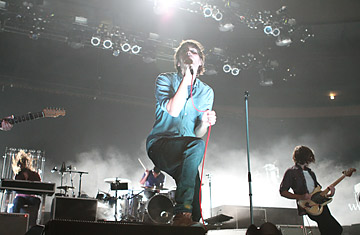
Thomas Mars of Phoenix performs in concert at Madison Square Garden on October 20, 2010 in New York City.
Over the weekend of Oct. 23-24, some 120,000 people will descend on 80 clubs, pubs, theaters, showrooms and lofts around New York City for the 30th annual CMJ Music Marathon. What started in 1981 as a series of music business seminars has grown into a multi-day festival featuring performances by over 1,200 bands, making it one of the largest, most comprehensive music events in the world. But unlike other festivals, which focus on the audience — Do you feel cool? Are you having fun? — CMJ's main purpose is to act as a showcase for the artists, a chance for unknown and unsigned bands to show their chops in front of the record producers, college-radio DJs and music marketers who just might be able to turn them into rock stars.
So much attention has been placed on acts who break out on the Internet — through MySpace, YouTube, or free mixtapes available for download — that it can be easy to discount the importance of these traditional live showcases, in which a band or artist performs for discerning music industry types. "People ask me, "why is it professionally helpful for a band to be just one of 1,200 acts?" says Robert Haber, founder and CEO of CMJ (which by the way, stands for College Music Journal). "But if you're that band, a CMJ performance helps distill you from the Internet universe of tens of thousands of bands." For decades, CMJ has acted as a music tastemaker; the company publishes a weekly independent and college radio trade magazine, CMJ New Music Report, for which the music festival serves as kind of physical embodiment.
It's a smaller pool, and with the CMJ label comes prestige. In 1983, the then-unknown R.E.M. performed a showcase at CMJ and generated so much buzz for their debut album, Murmur, that in some music circles people are still talking about it. In 2003, the Killers repeated the process; they played a CMJ showcase just as their single "Mr. Brightside" made its initial foray onto the airwaves. This year, 4,000 artists sought spots in the festival, in hopes that they might become the Next Big Thing. "It is a beast," says Haber. "We've done it for a long time but you can still never be fully prepared for when a band breaks big."
For the first eight years, industry panel discussions — mostly about the ins and outs of college radio — dominated the festival, while a handful of nighttime performances offered entertaining respite. Haber says that changed in 1989, when Soundgarden, the Red Hot Chili Peppers, and the Gin Blossoms put on such a big show at New York's Beacon Theater that the following year, "everyone requested tickets to the shows and we realized we had to expand." CMJ spread to a handful of venues around the city. Then a handful more. Now its 80 venues reach from Manhattan into Brooklyn, Long Island and even New Jersey.
At this year's biggest concert, French dance-rockers Phoenix performed for a packed house at New York City's Madison Square Garden — the first time the music festival has filled such a massive space — accompanied for a few songs by electronica veterans Daft Punk. Phoenix is one of those European bands who always seem on the brink of crossing over into the U.S. market but haven't quite hit. "Their rise in the States has been steady, but pretty subdued," says Haber. "To have as CMJ's first arena show a band that's huge overseas but relatively small here really speaks to the purpose of the festival."
Phoenix and Daft Punk aren't the only big names at this year's CMJ festival. Organizers have expanded into the video game market and partnered with Green Day's American Idiot Broadway cast. They will even host shows at New York City's Lincoln Center.
So who will be the CMJ's break-out bands of 2010? Check back for a post CMJ wrap-up next week on Time.com.
